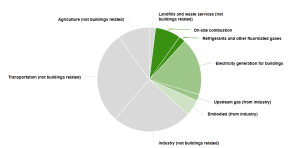Decarbonizing the U.S. Economy by 2050: A National Blueprint for the Buildings Sector

News Detail

Source:
Energy.gov - U.S Department of EnergyThe U.S. Department of Energy led the development of a Blueprint for decarbonizing U.S. buildings by 2050 to lay out a national strategy for aggressively reducing building greenhouse gas emissions while delivering equity, affordability, and resilience benefits to communities. The vision includes action the federal government can take to meet specific targets for increasing building energy efficiency, accelerating onsite emissions reductions, transforming the grid edge, and minimizing embodied life cycle emissions.
The national strategy reflects the central role that buildings play in achieving economy-wide climate goals while delivering cost savings, healthier environments, and high-quality jobs for the American people. Federal agency coordination and support for state and local actions is essential to accelerate the transition to low-carbon buildings.
The Blueprint aims to reduce greenhouse gas emissions from U.S. buildings 65% by 2035 and 90% by 2050 vs. 2005 while centering equity and benefits to communities.
The Blueprint sets three cross-cutting goals of equity, affordability, and resilience to ensure that the low-carbon buildings transition benefits disadvantaged communities, reduces energy costs, and increases the ability of communities to withstand stresses. Alongside those three cross-cutting goals, the Blueprint identifies four strategic objectives with specific performance targets that enable overall emission reductions.
Strategic objectives
Click on the icons below for an overview.
Increase building energy efficiency
Accelerate onsite emissions reductions
Transform the grid edge
Minimize embodied life cycle emissions
Achieving deep decarbonization of buildings is critical for reaching net-zero emissions economy-wide.
Buildings are responsible for more than a third of total U.S. greenhouse gas emissions. Decarbonizing the buildings sector has additional broad benefits, including saving people money, improving the quality of homes and businesses, reducing the size of new power grid infrastructure, and enabling fast, secure, and interactive distributed energy resources like on-site solar panels, battery storage, and EV charging.

The buildings sector contributed an estimated 35% of total U.S. greenhouse gas (GHG) emissions in 2021, including estimated portions of the industrial sector for embodied building life cycle emissions and the buildings-sector share of emissions from natural gas production and distribution. Source: U.S. Department of Energy analysis of U.S. Environmental Protection Agency’s Inventory of U.S. GHG Emissions and Sinks: 1990-2021.
Meeting the goals set in the Blueprint will have far-reaching impacts.
The Blueprint’s vision would reduce building greenhouse gas emissions to within reach of net zero while also reducing building energy use by one third, unlocking billions of dollars in energy and health cost savings, and requiring investments that can support new clean energy jobs.
